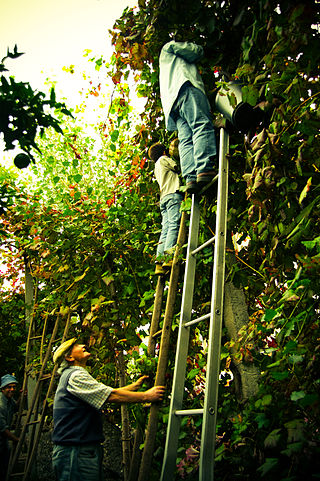
Vinho Verde refers to Portuguese wine that originated in the historic Minho province in the far north of the country. The modern-day 'Vinho Verde' region, originally designated in 1908, includes the old Minho province plus adjacent areas to the south. In 1976, the old province was dissolved.
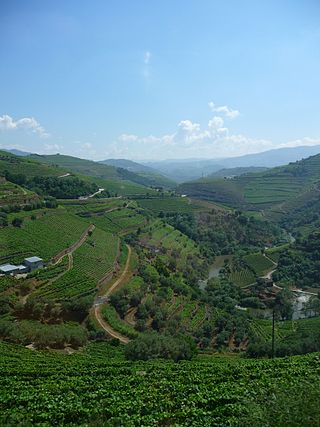
Douro is a Portuguese wine region centered on the Douro River in the Trás-os-Montes e Alto Douro region. It is sometimes referred to as the Alto Douro, as it is located some distance upstream from Porto, sheltered by mountain ranges from coastal influence. The region has Portugal's highest wine classification as a Denominação de Origem Controlada (DOC) and is registered as a Protected Designation of Origin under EU and UK law, and as a Geographical Indication in several other countries through bilateral agreements. While the region is best known for Port wine production, the Douro produces just as much table wine as it does fortified wine. The non-fortified wines are typically referred to as "Douro wines".
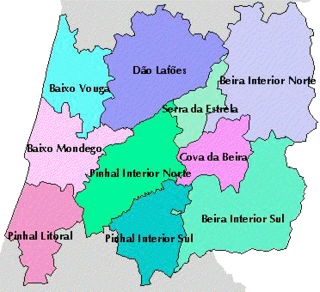
Dão is a Portuguese wine region situated in the Região Demarcada do Dão with the Dão-Lafões sub region of the Centro, Portugal. It is one of the oldest established wine regions in Portugal. Dão wine is produced in a mountainous region with a temperate climate, in the area of the Rio Mondego and Dão rivers in the north central region of Portugal. The region became a Denominação de Origem Controlada (DOC) appellation in 1990. The Dão region is the origin of the Touriga Nacional vine that is the principal component of port wine.
Bairrada is a Portuguese wine region located in the Beira Litoral Province. The region has Portugal's highest wine classification as a Denominação de Origem Controlada (DOC), and its popularity has surged over the last years. It is small and quite narrow coastal region, part of the broader region of Beira Atlântico, and it is bordered to the northeast by the Lafões IPR and to the east by the Dão DOC.

Alentejo is a Portuguese wine region in the Alentejo region. The entire region is entitled to use the Vinho Regional designation Alentejano VR, while some areas are also classified at the higher Denominação de Origem Controlada (DOC) level under the designation Alentejo DOC. VR is similar to the French vin de pays and DOC to the French AOC. In the southern half of Portugal, the Alentejo region covers about a third of the country and is sparsely populated. In 2005, South Oregon University scientist Gregory V. Jones identified Alentejo as the world's most challenged wine region from a climate change perspective. The region is noted for it vast cork production but has in recent years garnered attention for its table wine production. Some producers of this region still do wine in great potteries as in Roman times.
Planalto Mirandes is a Portuguese wine region centered on the town of Miranda do Douro in the Trás-os-Montes e Alto Douro region. The region was initially a separate Indicação de Proveniencia Regulamentada (IPR) region, but in 2006, it became one of three subregions of the Trás-os-Montes DOC, which has the higher Denominação de Origem Controlada (DOC) status. Its name may still be indicated together with that of Trás-os-Montes, as Trás-os-Montes-Planalto Mirandês.
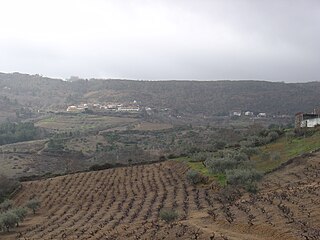
Valpaços is a Portuguese wine region centered on the town of Valpaços in the Trás-os-Montes e Alto Douro region. The region was initially a separate Indicação de Proveniencia Regulamentada (IPR) region, but in 2006, it became one of three subregions of the Trás-os-Montes DOC, which has the higher Denominação de Origem Controlada (DOC) status. Its name may still be indicated together with that of Trás-os-Montes, as Trás-os-Montes-Valpaços. Located along the Tua River, the region is known for its slightly sparkling rosé.

Távora-Varosa is a Portuguese wine region located in the northwestern section of the Beiras region. The region is designated as Denominação de Origem Controlada (DOC) after it was promoted from its former Indicação de Proveniencia Regulamentada (IPR) status, when it was called Varosa IPR. At the same time, the former Encostas da Nave IPR, bordering the Douro, was absorbed into the Távora-Varosa DOC.
Moscatel de Setúbal is a Portuguese muscatel produced around the Setúbal Municipality on the Península de Setúbal. The region is known primarily for its fortified Muscat wines known as Moscatel de Setúbal. The style was believed to have been invented by José Maria da Fonseca, the founder of José Maria da Fonseca, the oldest industrial-scale table wine producer in Portugal dating back to 1834. J.M. Fonseca company still holds a quasi-monopoly control over the production of Moscatel de Setúbal today.

Algarve is a Portuguese wine region covering the same areas as its namesake region. The region is classified as a Vinho Regional (VR), a designation similar to a French vin de pays region. Located on the southern coast of Portugal, the region's wine industry is driven by the local tourist economy with very few wines being exported.

Beiras is a Portuguese wine region producing wines with the classification Denominação de Origem Controlada. Located in the northern regions of Portugal, the Beiras region produces a wide range of wines, including sparkling and fortified wine. Quality varies dramatically depending on producer and region.
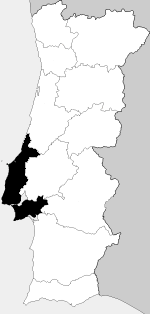
Lisboa, until 2009 named Estremadura, is a Portuguese wine region covering the same areas as the Estremadura region, and taking its name from the country's capital. The region is classified as a Vinho Regional (VR), a designation similar to a French vin de pays region. While the Beiras and Alentejo VRs are largest geographically, the Lisboa region is Portugal's largest producer of wine by volume. The region stretches from Lisbon along the Atlantic coast to the Bairrada DOC.

Tejo, until 2009 named Ribatejo, is a Portuguese wine region covering the same areas as the Ribatejo Province. It takes its name from the river Tejo (Tagus). The entire region is entitled to use the Vinho Regional designation Tejo VR, while some areas are also classified at the higher Denominação de Origem Controlada (DOC) level under the designation DoTejo DOC. VR is similar to the French vin de pays and DOC to the French AOC.

Minho, formerly Rios do Minho, is a Portuguese wine region covering the same areas as the Vinho Verde DOC. The region is classified as a Vinho Regional (VR), a designation similar to a French vin de pays region. The wines of the Minho and Vinho Verde are nearly identical except for the Minho VR allowing foreign grape varieties to be used that are excluded from the Denominação de Origem Controlada (DOC) regulations for Vinho Verde.
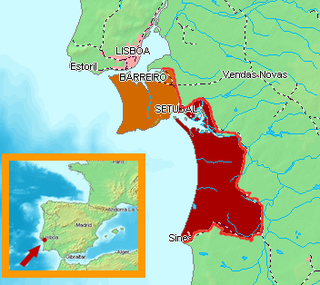
Península de Setúbal, until 2009 named Terras do Sado, is a Portuguese wine region covering Península de Setúbal and most of the Sado River region. The area is classified as a Vinho Regional (VR), a designation similar to a French vin de pays region. With the Setúbal DOC to the northwest and the Atlantic Ocean to the west, the region is almost completely surrounded by the Alentejo VR.
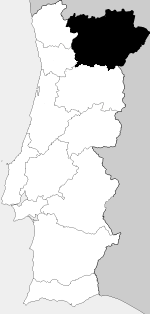
Trás-os-Montes is a Portuguese wine region located in the Trás-os-Montes e Alto Douro region. The entire wine region is entitled to use the Vinho Regional designation Transmontano VR, while some areas are also classified at the higher Denominação de Origem Controlada (DOC) level under the designation Trás-os-Montes DOC. VR is similar to the French vin de pays and DOC to the French AOC.
Arinto or Arinto de Bucelas is a white Portuguese wine grape planted primarily in the Bucelas, Tejo and Vinho Verde regions. It can produce high acid wines with lemon notes.
Rabo de Ovelha is white Portuguese wine grape variety that is grown all over Portugal. It should not be confused with the red Rabo de Anho grape variety that is found in the Vinho Verde region. Rabo de Ovelha is an authorized grape variety in the Bairrada, Borba, Bucelas, Redondo, Reguengos, Setúbal and Vidigueira Denominação de Origem Controlada (DOC). The grape variety gets its name from the way its grape bunches resembles the end of a ewe's tail. In winemaking, Rabo de Ovelha is known for producing highly alcoholic wines that wine expert Jancis Robinson describes as lacking subtlety.



















